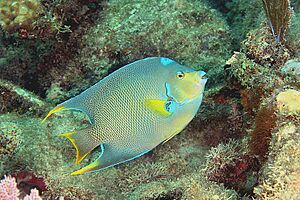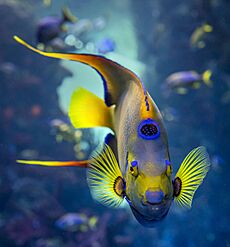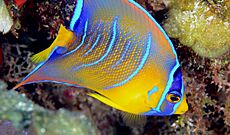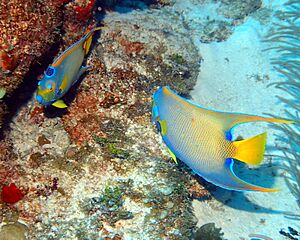Queen angelfish facts for kids
Quick facts for kids Queen angelfish |
|
|---|---|
 |
|
| Adult | |
| Conservation status | |
| Scientific classification | |
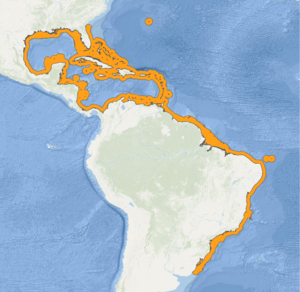 |
|
| Range of the queen angelfish | |
| Synonyms | |
|
Chaetodon ciliaris Linnaeus, 1758
Angelichthys ciliaris (Linnaeus, 1758) Chaetodon squamulosus Shaw, 1796 Chaetodon parrae Bloch & Schneider, 1801 Holacanthus coronatus Desmarest, 1823 Holacanthus formosus Castelnau, 1855 Holacanthus iodocus Jordan & Rutter, 1897 Angelichthys iodocus (Jordan & Rutter, 1897) Holacanthus lunatus Blosser, 1909 |
The queen angelfish (Holacanthus ciliaris) is a beautiful species of marine angelfish. It is also known as the blue angelfish, golden angelfish, or yellow angelfish. You can find this fish in the western Atlantic Ocean.
Queen angelfish live in warm waters on the coral reef floor. They are easy to spot because of their bright blue and yellow colors. They also have a special spot, like a "crown," on their forehead. This crown helps tell them apart from the similar Bermuda blue angelfish. Sometimes, these two types of angelfish even have babies together!
Adult queen angelfish mostly eat sponges. They live in groups called harems, with one male and a few females. The male looks after his territory while the females find food. They usually lay their eggs around the full moon. The tiny, clear eggs float until they hatch. Young angelfish look different from adults and help clean bigger fish.
Many people like to keep queen angelfish in their aquariums. They are often caught and sold from places like Brazil. Experts say the queen angelfish population is stable, so it is not currently at risk.
Contents
About the Queen Angelfish Name
The queen angelfish was first described in 1758 by a famous scientist named Carl Linnaeus. He gave it the name Chaetodon ciliaris. Later, in 1802, another scientist moved it to the group Holacanthus. This name comes from old Greek words meaning "full thorn," which might refer to its scales.
The name ciliaris means "fringed," probably because of its scales. People also call this fish the "blue angelfish," "golden angelfish," or "yellow angelfish."
Queen Angelfish Family Tree
Marine angelfish like the queen angelfish likely appeared millions of years ago. The oldest type of Holacanthus angelfish is the Guinean angelfish, found near West Africa. This suggests that these fish spread from the Indian Ocean to the Atlantic.
About 1.5 million years ago, the queen angelfish split from its closest relative, the Bermuda blue angelfish. These two species can still breed together. When they do, they create a hybrid fish called the Townsend angelfish. This hybrid looks like both parents and can even have its own babies.
Here is a simple family tree showing how the queen angelfish is related to other angelfish:
| Holacanthus |
|
||||||||||||||||||||||||||||||||||||
What Queen Angelfish Look Like
The queen angelfish has a wide, flat, oval-shaped body. Its tail fin is shaped like a triangle. It has a small mouth with teeth like bristles. The top fin (dorsal fin) has 14 stiff spines and 19–21 soft rays. The bottom fin (anal fin) has 3 spines and 20–21 soft rays. Both the top and bottom fins hang down behind its body.
This fish can grow up to 45 centimeters (about 18 inches) long. It can weigh up to 1.6 kilograms (about 3.5 pounds). Males are sometimes bigger than females.
Colors and Markings
The queen angelfish is covered in blue-green scales with yellow tips. Its tail, pectoral fins (side fins), and pelvic fins (bottom fins) are bright yellow. The ends of its top and bottom fins are orange-yellow. Its pectoral fins have blue patches near their base.
On its forehead, there is a special eye-like spot, or "crown." This crown is a deep cobalt blue color. It has an electric blue ring around it and electric blue dots inside. This crown is the main way to tell it apart from the Bermuda blue angelfish.
Young Queen Angelfish
Young queen angelfish look different from adults. They are dark blue with bright blue vertical stripes. Their pectoral area is yellow. They look a lot like young blue angelfish, but their stripes are more curved. As they grow, their colors slowly change to the adult pattern.
Sometimes, queen angelfish can have different color patterns. For example, some are mostly gold or bright orange. Others might be bright blue with some yellow, black, or white. A few have even been seen that are all white!
Where Queen Angelfish Live and What They Eat

Queen angelfish live in warm, tropical, and subtropical parts of the Western Atlantic Ocean. You can find them near the coasts and islands of the Americas. Their home stretches from Florida through the Gulf of Mexico and the Caribbean Sea all the way down to Brazil. They also live as far east as Bermuda.
These fish are bottom-dwellers, meaning they live near the ocean floor. They can be found in shallow waters close to shore, down to about 70 meters (230 feet) deep. They prefer to live in coral reefs, especially where there are soft corals. They usually swim alone or in pairs.
What They Eat
Queen angelfish eat a variety of foods. Their diet includes sponges, tunicates (sea squirts), jellyfish, corals, plankton (tiny ocean life), and algae (seaweed).
Young queen angelfish act as "cleaner fish." They set up special "cleaning stations" where they remove tiny parasites from bigger fish. For adult angelfish, sponges are a very important part of their diet. In some areas, sponges make up 90% of what they eat! They seem to be picky eaters, choosing specific types of sponges even if they are not the most common ones.
Queen Angelfish Life Cycle
Male queen angelfish have large areas they consider their home. In these areas, they live with a harem of two to four females. Scientists think that these fish might be "protogynous hermaphrodites." This means that the largest female in a harem could change into a male if the current male disappears.
Around the middle of the day, the females go off to find food by themselves. The male checks on each of them, swimming quickly towards them, circling them, and eating nearby. Queen angelfish can lay eggs all year round. This usually happens around the time of a full moon.
Reproduction and Young Fish
During courtship, the male shows his side to the female. He might also flick his pectoral fins or "soar" above her. When they are ready to lay eggs, the female swims towards the surface. The male swims under her, pressing his snout against her belly. Then, they release their eggs and sperm into the water. A female can release between 25,000 and 75,000 eggs each day! After laying eggs, the pair separates and swims back to the ocean floor.
The eggs are clear and float in the water for about 15–20 hours. When they hatch, the tiny larvae have a large yolk sac for food. They don't have working eyes, guts, or fins yet. After two days, the yolk is gone, and the larvae start to look more like fish. These larvae eat tiny plankton and grow very fast.
When they are about three to four weeks old, and about 15 to 20 millimeters (0.6 to 0.8 inches) long, they swim down to the ocean floor. At this stage, they are called juveniles. Young angelfish live alone in areas with finger sponges and coral. Here, they set up their own cleaning stations to help clean other fish.
Queen Angelfish and People
Queen angelfish are not usually caught for food or for large-scale commercial fishing. They are mostly caught for the aquarium trade. People really value them for their beauty in home aquariums.
Young angelfish can learn to eat regular aquarium food. This means they have a better chance of surviving in an aquarium than adult fish, which need a more specific diet.
In Brazil, the queen angelfish is one of the most popular marine fish sold for aquariums. In 2010, experts said the queen angelfish was of "least concern" for conservation. This means its wild population seems to be healthy and stable.
Sometimes, queen angelfish have been found in places like the eastern Adriatic Sea and the Mediterranean Sea. These fish likely escaped or were released from aquariums. They are not naturally found in these areas.



